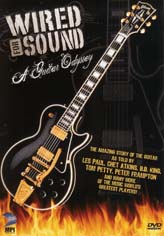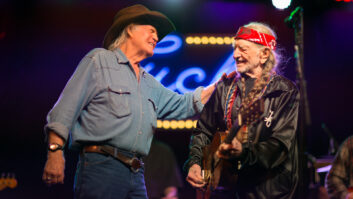
Wired for Sound: A Guitar Odyssey
(MPI Home Video)
Okay, the first thing you need to know about this excellent documentary about guitars and guitarists is that it’s really only about one brand of guitar—Gibson—and the folks who’ve played them through the years. This fact is not prominent on the DVD box (though a picture of a Gibson Les Paul is). The name Leo Fender does not appear in this film; you will not see Jimi Hendrix caressing his Strat; Adolph Rickenbacker doesn’t get his due, either. If those are deal-breakers for you, you might want to look elsewhere for some more objective “story of the guitar” (as this bills itself).
Nevertheless, what’s here is actually quite fascinating and very well put together (by director Mark Hall and his crew). It’s not even a strict chronological history of Gibson; indeed, we learn almost nothing about company founder Orville Gibson and the early days of the company. Rather, it’s a more impressionistic documentary, weaving quotes from a slew of great guitarists about how they got into playing, people who influenced them, the seductiveness of guitars, etc., with plenty of illustrative archival footage and modern demonstrations of technique from various styles of guitarists—rock, country, metal, a little jazz—and a couple of really good token bassists—the late John Entwistle of The Who and Jefferson Airplane/Hot Tuna’s Jack Casady. One thing I really like about it is that it is not America-centric; indeed, some of he most illuminating pickers are Brits, including Peter Frampton, Glen Tipton of Judas Priest, Bad Company’s Mick Ralphs, Yes’ Steve Howe and Black Sabbath’s Tommy Iommi, who reveals that his first instrument was the accordion and that it was the inspiration of Django Reinhart, who overcame a crippling deformity (caused by a fire), that allowed Iommi to get past his own physical shortcomings and become a guitarist.
Django is one of several historical figures who gets substantial credit here as an innovator: Chet Atkins talks about getting the Gypsy guitarist’s autograph; Peter Frampton wore out his dad’s Django records after initially hating them. The great B.B. King rhapsodizes about the influence of T-Bone Walker, whom he describes as “the first showman of the guitar.” Scotty Moore, of Elvis Presley’s great trio, gets his props, too, as does Charlie Christian, Chuck Berry, John Lee Hooker (The Doors’ Robbie Kreiger talks about the impact of being high on acid and hearing Hooker!) and, of course, Les Paul. Randy Bachman tells a nice story about being too young to get into a club in Winnipeg to see Les Paul and Mary Ford, so he watched through the round windows on the venue’s kitchen doors and heard what he could when they’d swing open. When Les came through the kitchen at the end of the night, he thrilled Bachman by teaching him the speedy two-string run from “How High the Moon,” and in the process helped set the young guitarist on his a career path. (As usual, though, Les Paul gets a little too much credit: Ron Wood is allowed to say, unchallenged, that “[Les] invented 80 to 90 percent of what we see in the studio today.” That’s okay, though—we still love Les!)
A number of the musicians talk about the truly mystical bond they have with their guitars—Bill Corgan of Smashing Pumpkins says that to him playing guitar is like breathing; Glen Tipton notes that a guitar “has a better shape than any woman”; Tom Petty describes how he was “bitten pretty hard at the age of 11…and I never had any interest in anything else again. If I have spare time, I look for guitars…It’s a bit sad, isn’t it?” he asks with a laugh.
There’s a very interesting segment on acoustic and electric rhythm guitar, with Emmylou Harris, Travis Tritt and Petty nicely articulating the subtle power of that particular skill, and how it complements singing so well. Emmylou mentions that an acoustic guitar style is “like a fingerprint”; a powerful image. Brent Mason and Jeff Baxter discuss the pressures and pleasures of being session guitarists, and a number of different players, from Slash to Charlie Daniels to Joe Perry of Aerosmith, talk about how they developed their personal styles. Another strength of the documentary is that most of the guitarists who were interviewed are sitting there with a guitar, frequently playing as they speak, sometimes just noodling idly, but also occasionally demonstrating a point by playing a riff or run. Chet Atkins shows his seemingly effortless command of his axe, and there are also informative demos by B.B. King, Don Felder (Eagles), Tritt, Frampton and many others.
One criticism of the project I have (aside from the Gibson bias, of course) is I would’ve liked to have seen all the various guitars clearly identified by model. We learn a lot about the 335 and the Les Paul and, to a lesser extent, the SG, but when Django or T-Bone Walker is shown in archival footage, we don’t learn what guitars they’re using; nor in the contemporary scenes shot for the documentary. Is that an old L-5? Is this other one a 335 or a 355? In fact, if we’re going all-Gibson, why not provide a linear history of what was introduced when? I love that kind of stuff!
Still, I heartily recommend this 75-minute documentary to anyone who’s passionate about guitars and guitar-playing.
Shameless plug: Blair Jackson’s latest book, Grateful Dead Gear, is filled with juicy photos of Gibson and many other kinds of guitars.







